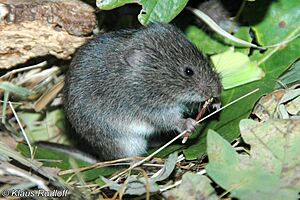Reed vole facts for kids
Quick facts for kids Reed vole |
|
|---|---|
 |
|
| Conservation status | |
| Scientific classification | |
| Genus: |
Alexandromys
|
| Species: |
fortis
|
| Synonyms | |
|
|
The reed vole (Alexandromys fortis) is a type of vole, which is a small rodent. You can find these voles in northern and central Eurasia, including places like northern China and the Korean Peninsula. Compared to most other voles, the reed vole is a bit bigger and has a longer tail.
Contents
What Does a Reed Vole Look Like?
The reed vole is one of the largest voles in its group, called Alexandromys. Adult reed voles grow to be about 120 to 139 mm (4.7 to 5.5 in) long from head to body. Their tails are usually between 48 to 67 mm (1.9 to 2.6 in) long.
Their fur on their back is a dark brownish-yellow color. The fur on their sides is a lighter brownish-yellow, which slowly changes to a grayish color on their belly. Their feet are light brown, and their tail has two colors: dark brown on top and whitish underneath.
Where Do Reed Voles Live?
Reed voles originally come from eastern Asia. They live in many areas, including parts of Russia, Mongolia, eastern China, and both North and South Korea.
They like to live in grassy plains called steppes and areas where forests meet grasslands. You can often find them near lakes and rivers, hiding among tall plants in wet meadows and marshes. If their homes get flooded, like in spring or summer, they might move to nearby farms or empty fields. However, they usually don't travel far, only about 5 km (3.1 mi), and they go back to their watery homes when the floods are gone. They can live in places as high as 2,000 m (6,600 ft) above sea level.
Reed Vole Behaviour and Habits
Reed voles are active both during the day and at night. They move slowly on land, but they are very good swimmers.
Reed Vole Homes
In dry soil, reed voles dig complex burrows. These burrows have many side tunnels, special rooms for nesting, places to store food, and several entrances. Their tunnels can go as deep as 120–150 cm (1.3–1.6 yd) underground.
In very wet areas, their burrows might be shallow or just simple paths on the ground. Near lakes and rivers, they sometimes build round nests up to 30 cm (12 in) wide. These nests are hidden in thick plants, and sometimes several nests are close together with clear paths connecting them.
What Do Reed Voles Eat?
In the spring and summer, reed voles mostly eat fresh shoots and leaves, along with grass stems. In the autumn, they collect grains and pieces of grass to store in their burrows. During this time of year, they also eat tree bark, roots, and the soft inside part of reeds. However, leaves seem to be their favorite food.
Reed Vole Life Cycle and Reproduction
Reed voles have babies between April and November. If conditions are good, a female vole can have up to six groups of babies in one season. Each group usually has about five young voles.
The mother carries her babies for about twenty days before they are born. Female voles can start having their own babies when they are about four months old. Males become ready to reproduce a little later than females.
Conservation Status
The reed vole is a common animal in most of the places it lives. Experts have not found any major threats to this species. Because of this, the International Union for Conservation of Nature (IUCN) says that the reed vole is of "least concern" for conservation. This means they are not currently at risk of disappearing.


